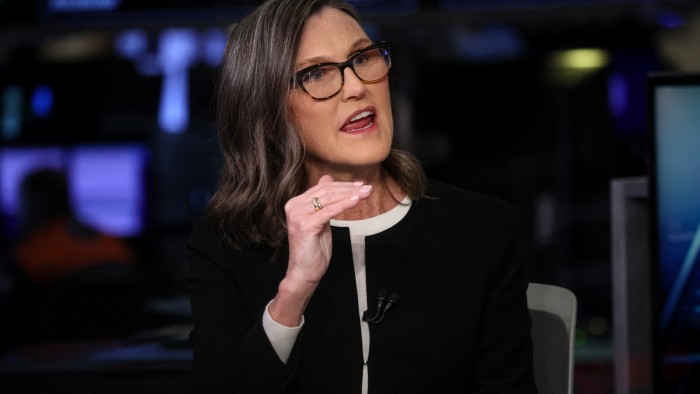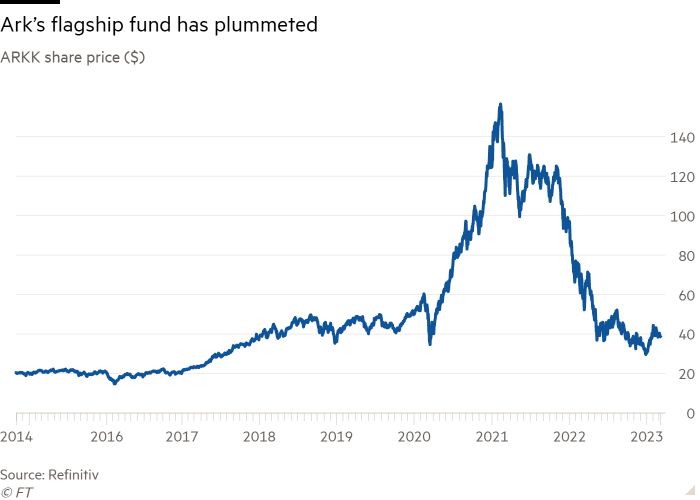Cathie Wood’s flagship Ark fund tops $300mn in fees despite losses

Simply sign up to the Investments myFT Digest -- delivered directly to your inbox.
Cathie Wood’s Ark Investment Management has earned more than $300mn in fees on its flagship exchange traded fund since its inception nine years ago, while wiping out almost $10bn of investors’ cash in the same period.
Investors have continued to plough money into the Ark Disruptive Innovation ETF, known by its ticker ARKK, over the past two years even though it has been badly burnt by the downturn in technology stocks.
Ark has earned more than 70 per cent of its $310mn fees since the fund’s valuation plummeted by nearly three quarters from its high in February 2021, according to FactSet data. This year it has brought in an average of roughly $230,000 in fees a day as ARKK’s value recovered slightly, rising by a quarter.
“Investment fees have provided ARK and Cathie Wood a very good living,” said Elisabeth Kashner, director of global funds, research and analytics at FactSet. “Her investors haven’t been so lucky.”
The fund manager has amassed a devoted following for her punchy bets on fast-growing tech companies, which until early 2021 produced outsized returns for investors and drew eye-popping inflows.

The ARKK fund has backed risky companies that it sees as radically reshaping the future in technology, robotics, biotechnology and space exploration.
More than $3bn flowed into ARKK in the first two weeks of February 2021 when the fund was up more than 700 per cent from its launch, bringing its assets to a peak of $27.9bn. But a rising interest rate environment that hammered growth stocks led to a slump in its value. It now manages $7.6bn in assets.
ARKK is unusually expensive — its annual management fee of 0.75 per cent of assets is about double the average for actively managed ETFs, according to FactSet.
The fee bill calls attention to ARKK’s unusually high investor retention for an ETF with such poor performance. Flows have remained resilient despite the fund losing $9.5bn in investor cash with Wood’s bold bets, according to Morningstar data.
“It’s extraordinary that investors who chased returns on the way up didn’t reverse course,” Kashner said. “The vast majority of investors have stuck with Cathie Wood.”
Many investors may be nursing losses so large they are unwilling to withdraw their funds. “There is a category of investor that is trapped,” said Ben Johnson, head of client solutions at Morningstar. “They’re anchored to the price at which they purchased it, and hoping it gets back there someway, somehow.”
The fund saw modest outflows when ARKK’s share price rebounded earlier this year, enabling investors to exit with reduced losses. “They saw a bounce, and it was a better opportunity to get out than it was last year,” said Todd Rosenbluth, head of research at VettaFi, a New York-based consultancy. “People don’t appear to be chasing strong performance.”
Johnson said the fund’s unusually high volatility had attracted a class of investors who used derivatives to generate returns from its large valuation swings.
“If their price chart squiggles enough and there is a sufficient level of volatility in the instrument’s price, it is going to attract demand from a very different crowd — I can’t use the word investor — that feeds off of, and profits from, volatility,” he said.
Strategies aiming to profit from ARKK’s volatile price — a triple leveraged short ARKK ETF launched in November 2021 — have further fuelled volatility in the underlying fund, according to Johnson.
Ark did not respond to a request for comment.
Wood said in a presentation to investors in late January that “innovation was punished” in the last quarter of 2022. But she reiterated her commitment to investing in “disruptive innovation” that would lead to “exponential growth trajectories” despite accruing big losses.
Since inception, ARKK investors have lost nearly 27 per cent in dollar- weighted returns — meaning on average, every dollar invested in the fund is now worth 73 cents, according to FactSet. Investors who bought at the peak are down more than 74 per cent.
“[Wood’s] fees are high for the sector,” Kashner said. “But investors have been their own worst enemy. People committed the cardinal sin of chasing returns.”
Comments